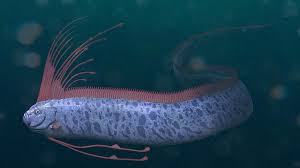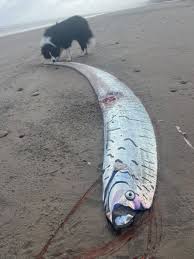
Wave of Fear: Giant “Doomsday Fish” Spotted Across Four Continents – From India to Mexico
October 9, 2025
A strange pattern of deep-sea visitors has set the internet abuzz and reignited old superstitions. In just under three weeks, the legendary oarfish, often called the “doomsday fish,” has appeared in waters and on beaches across India, Australia, New Zealand, and Mexico, stirring both curiosity and unease.
The sleek, silver creature, which can grow up to 36 feet long, typically lives thousands of feet below the surface. Its rare appearances have long been associated in Japanese folklore with impending natural disasters, especially earthquakes and tsunamis.
India: The Giant of Tamil Nadu
In Tamil Nadu, India, fishermen were left stunned when they hauled in a massive oarfish earlier this month. The creature, estimated to be over 15 feet long, was so enormous that seven men were required to lift it for photographs.

Videos of the scene quickly went viral across social media, with locals referring to it as a “bad omen from the sea.” The fishermen, however, seemed more fascinated than fearful, with one remarking that it was “the biggest fish we have ever seen, like something from another world.”
Marine experts in India later identified the specimen as a ribbon-like oarfish, one of the longest bony fish species on Earth. Scientists said its appearance near the surface could be linked to oceanic temperature shifts or illness, not seismic activity, but the folklore-driven panic continued to spread online.
Australia: Oarfish Washes Ashore in Tasmania

On Tasmania’s eastern coast, beachgoers were shocked to find another massive oarfish washed ashore. Measuring nearly 20 feet, the silvery, snake-like fish drew crowds who rushed to take photos before local authorities cordoned off the area for examination. Many residents described the scene as “eerie,” with one witness telling local media that it “looked like a dragon washed up from the deep.”
Scientists from the University of Tasmania confirmed it as an oarfish and collected tissue samples to study possible causes for its death. Social media users in Australia revived the nickname “doomsday fish,” noting the unsettling coincidence of its appearance amid ongoing earthquake activity in the Pacific region.
New Zealand: Headless Oarfish Mystifies Locals
The most chilling discoveries came from New Zealand, where two headless oarfish carcasses were found just days apart, one near Dunedin and another in Christchurch. Photos posted online showed the enormous, decapitated bodies, sparking intense speculation. Some claimed the headless state was proof of environmental distress or even deep-sea pressure trauma, while others saw it as a “sign of bad luck.”

Locals gathered at the beach in shock, describing the find as “unsettling” and “like a message from the ocean.” Marine biologists, however, have not linked the deaths to any seismic threat, suggesting instead that the fish may have suffered injuries from propellers or predators.
Mexico: Deep-Sea Visitor in Baja

Meanwhile, in Baja California, Mexico, divers encountered a live oarfish gliding near the surface, its metallic body shimmering under the waves. Video footage of the encounter quickly went viral, showing the oarfish’s ghostly movements as it swam gracefully before disappearing into the deep. Local residents recalled similar sightings before the 2010 Baja earthquake, rekindling old beliefs that the fish is a harbinger of seismic unrest.
Marine researchers from Mexico’s National Autonomous University downplayed those fears, emphasizing that “while the timing may appear eerie, there is no scientific proof linking oarfish appearances to earthquakes.”
Folklore Meets Science
Historically, oarfish sightings have been tied to Japanese legends that describe them as “messengers of the sea god Ryūjin,” appearing to warn humanity of underwater disturbances. Multiple oarfish were reportedly found before Japan’s 2011 Tōhoku earthquake and tsunami, further embedding the creature’s apocalyptic reputation.
Still, experts maintain that environmental stressors such as temperature changes, deep-sea quakes, or chemical pollution are more likely explanations for their recent surfacing. “It’s a spectacular biological event,” says one oceanographer, “but not a supernatural one.”
As the “doomsday fish” continues to resurface across continents, scientists and superstition clash once again, leaving the world to wonder: is nature sending a warning, or are we simply witnessing its mysteries unfold?